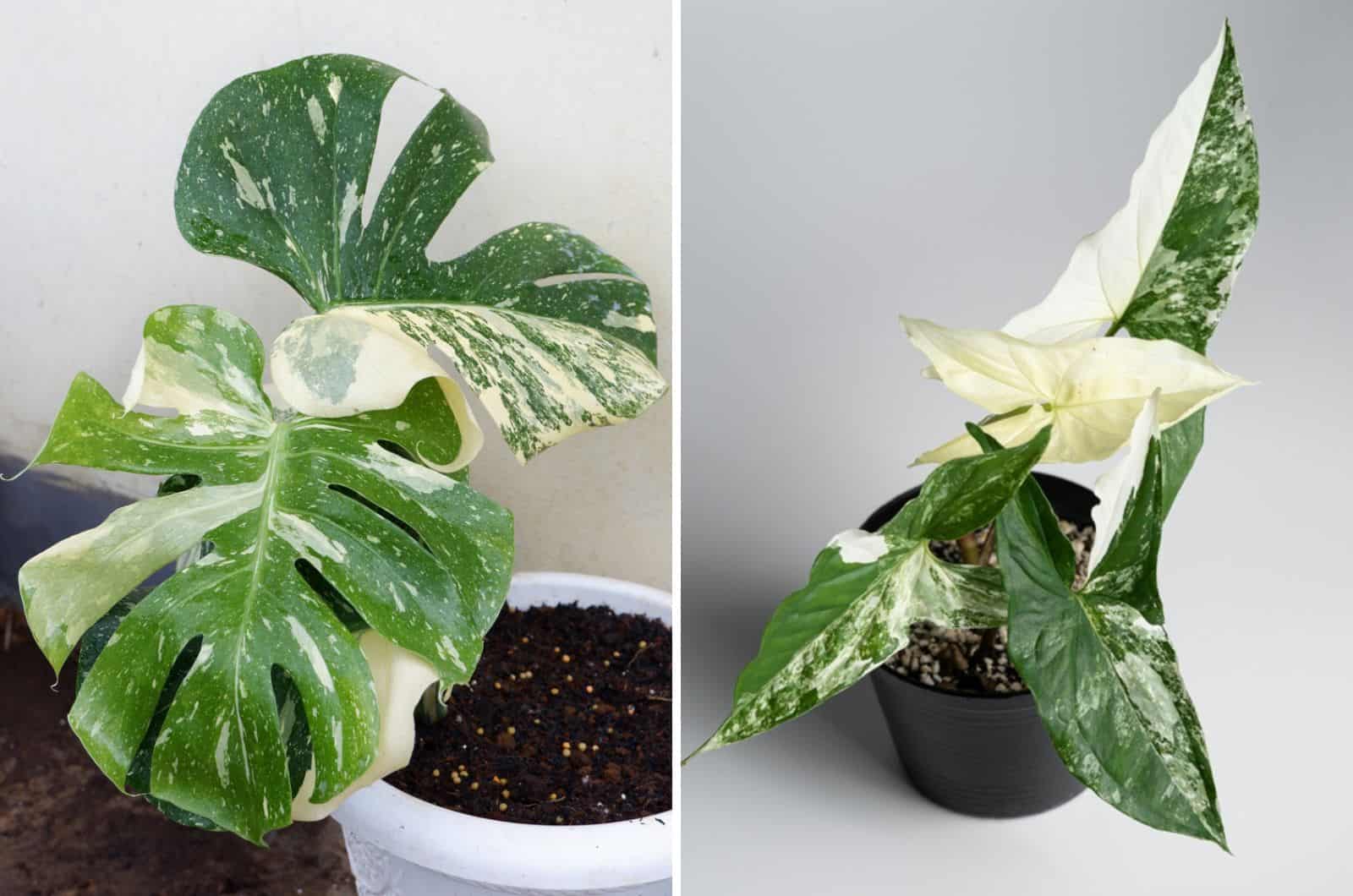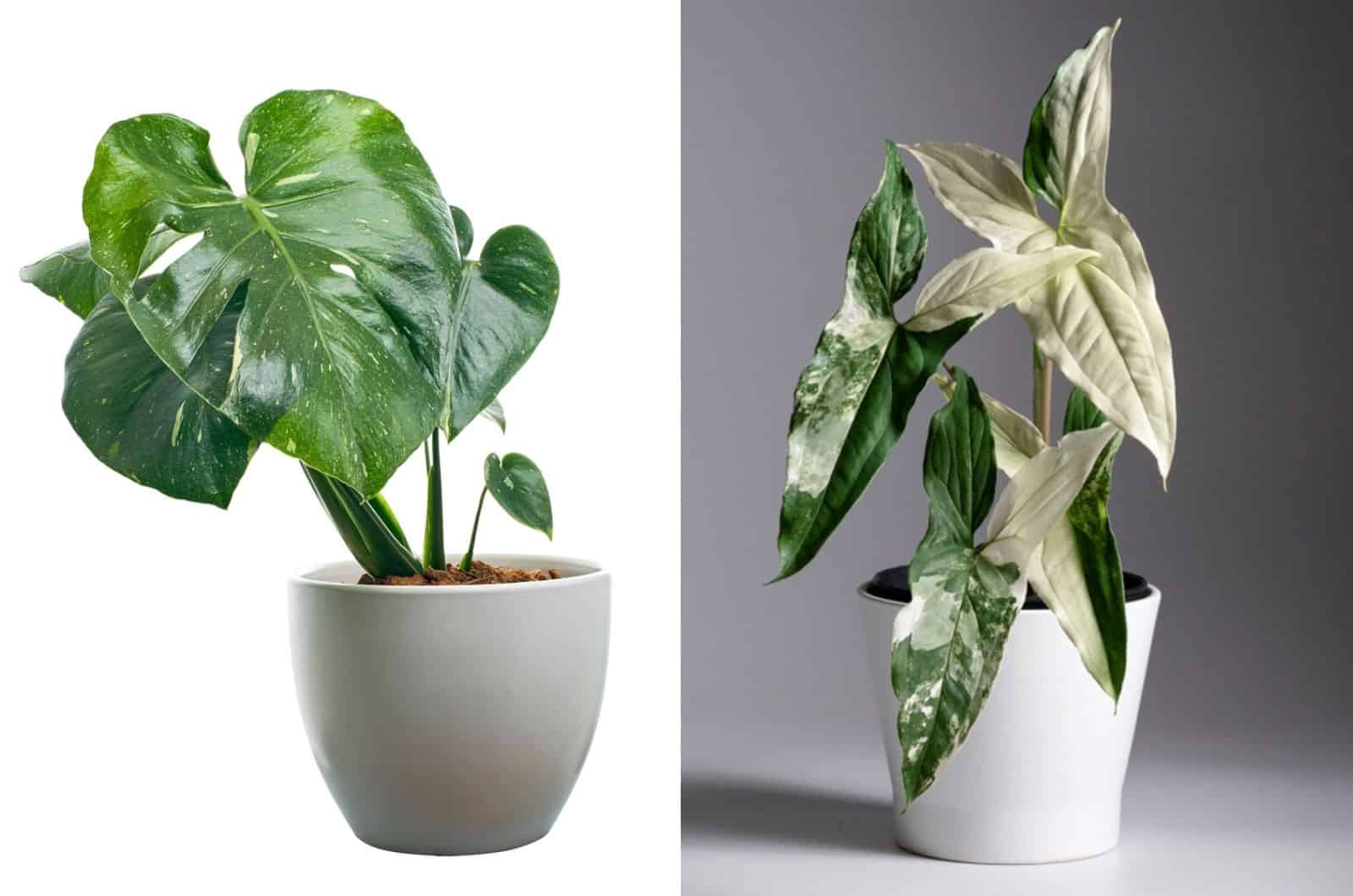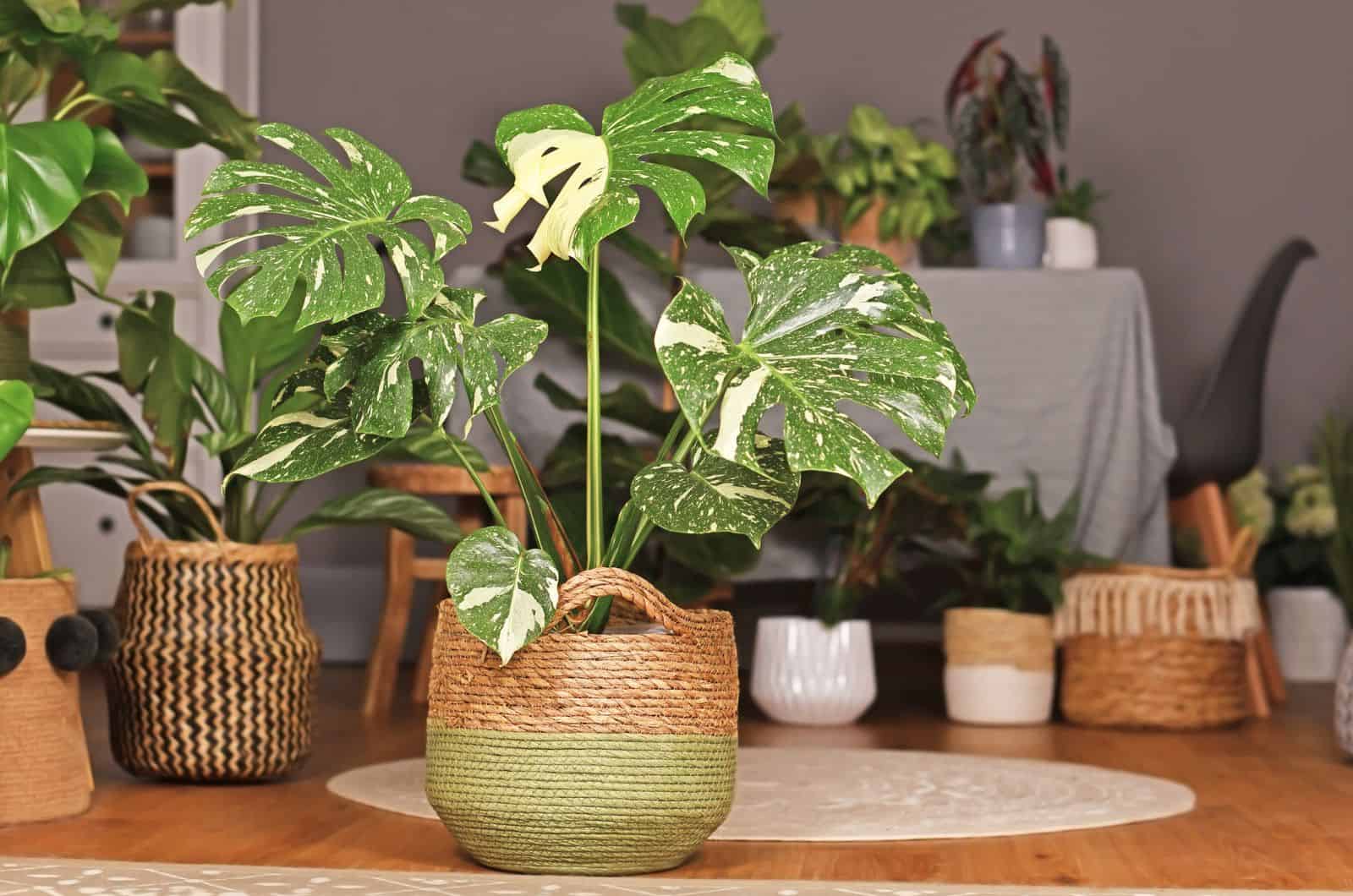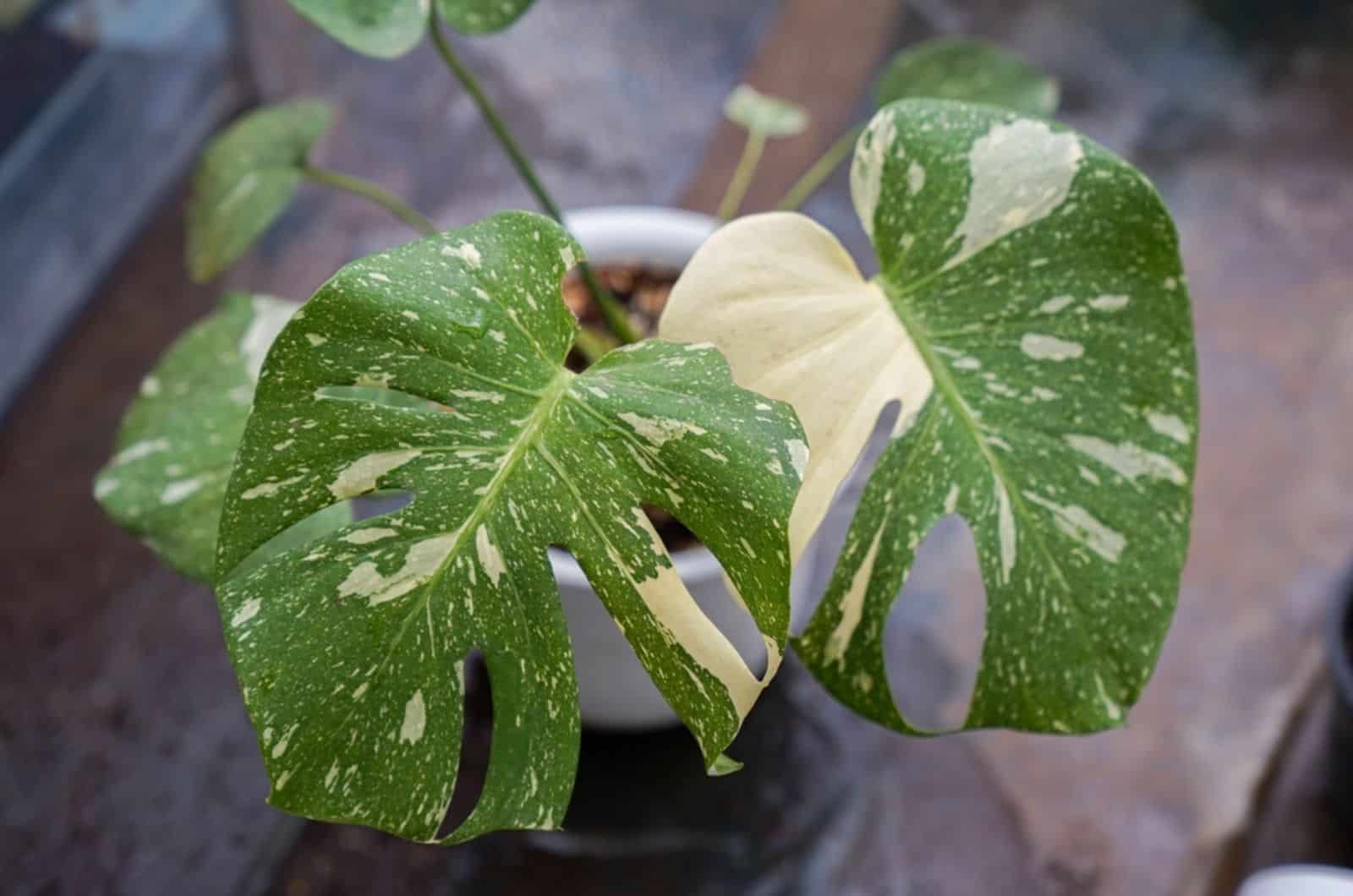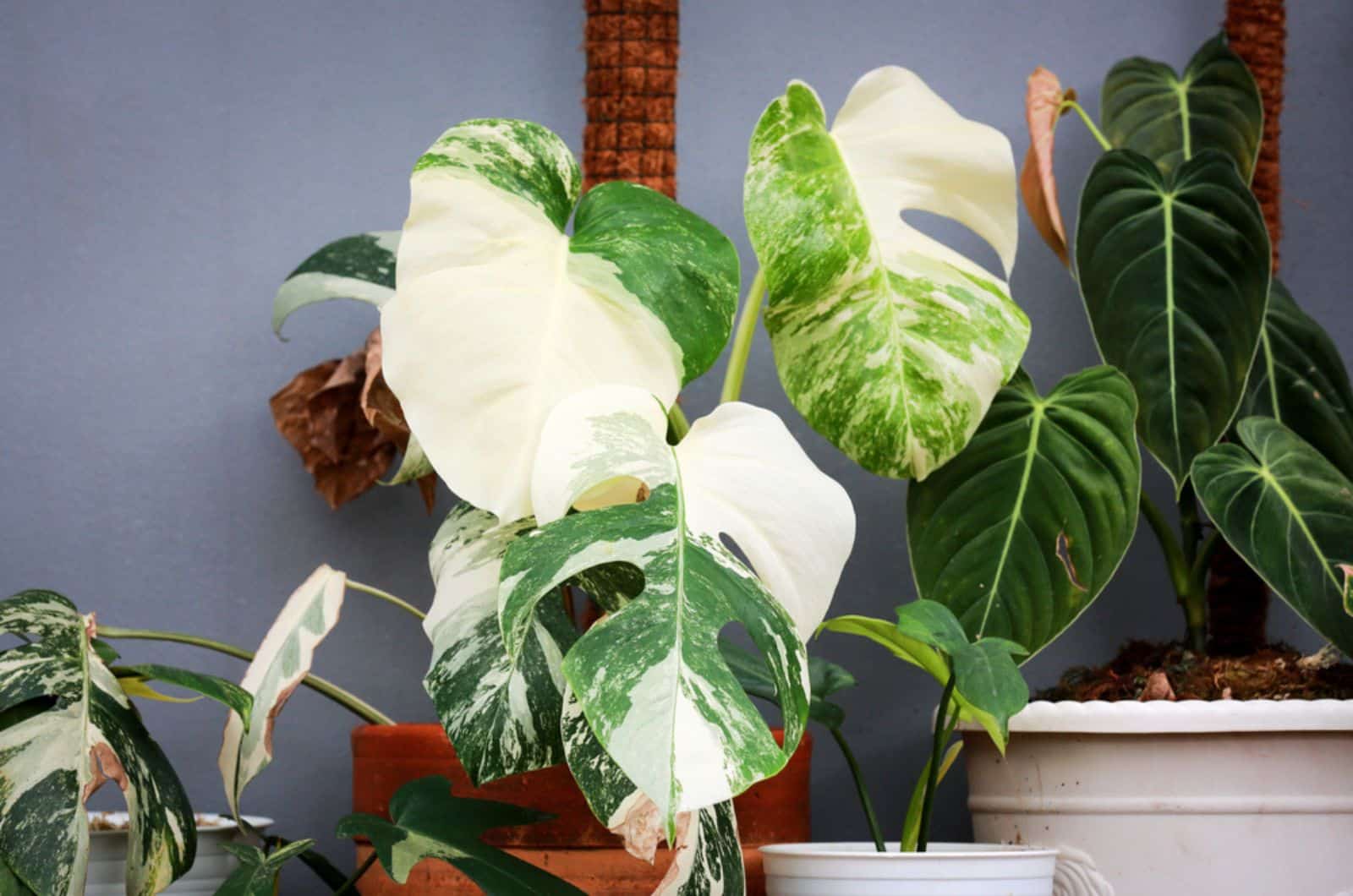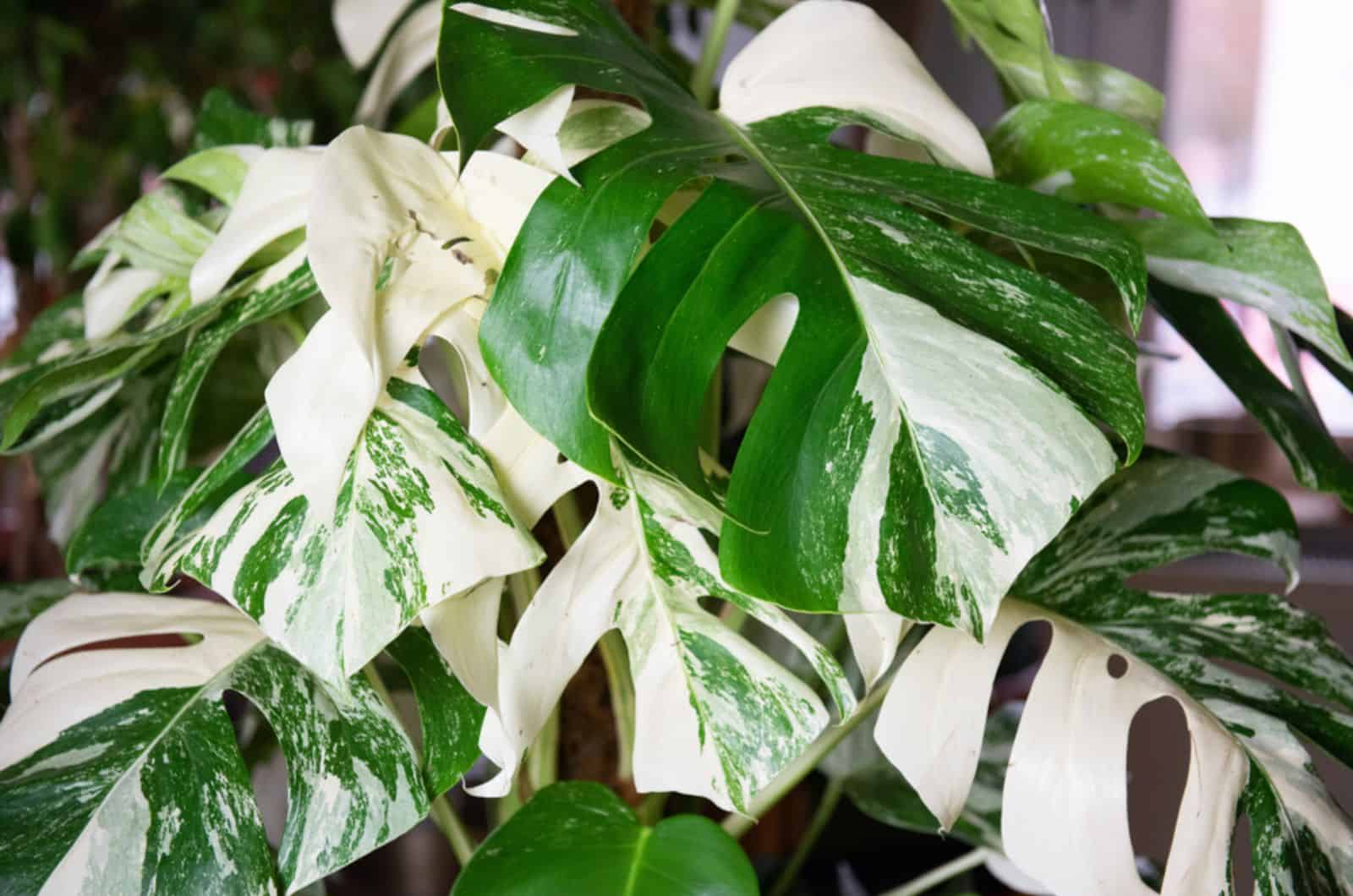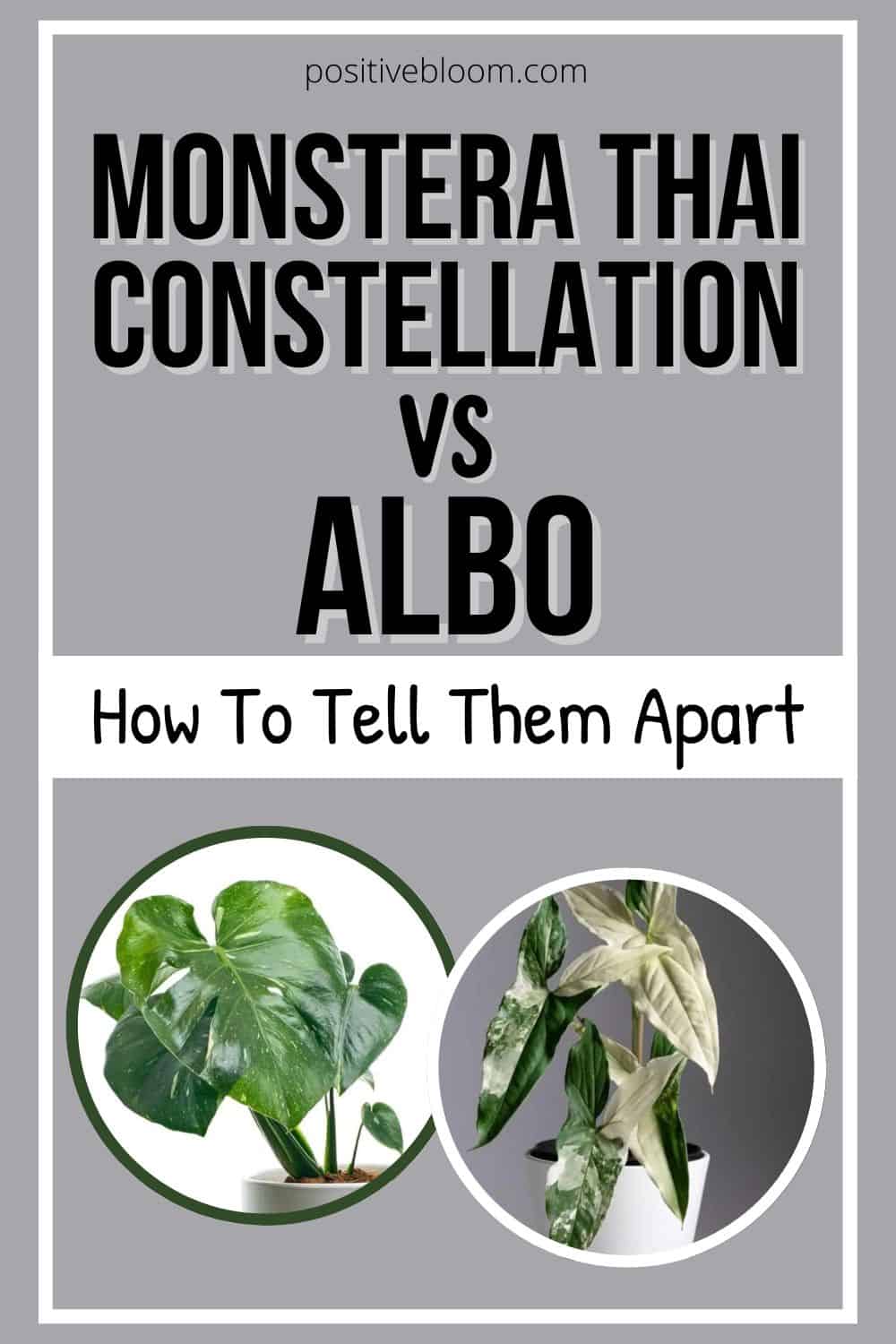Plants from the Monstera genus are undoubtedly the most common and magnificent indoor plants. This is due to the fact that they are low-maintenance, beneficial, and have a stunning appearance.
The most common species from this genus is Monstera deliciosa, a fantastic plant known for its fenestrated green leaves.
The Deliciosa, also known as split-leaf Philodendron, has many varieties, including the Monstera borsigiana. However, there are also variegated deliciosas.
Today, I’ll show you the most common variegated species that are often mistaken for each other.
When it comes to Monstera thai constellation vs albo, there’s loads to learn. But don’t worry, you’ll find everything you need to know right here, from the differences to the similarities as well as a plant care guide.
But first, here’s some basic info about these two plants.
[table id=299 /]
Let’s get started!
Monstera Thai Constellation vs Albo: The Differences
The difference between Monstera thai constellation vs albo is in variegations, types of variegations, size and shape, and price.
Let’s get into details!
Variegation
First, let’s discuss what the variegations look like on the Thai constellation plant. They look like someone took spackling paste and patched the holes!
Variegations on the Thai constellation seem to have a warmer and creamier white hue, and sometimes you can notice the variegations change to a light golden color.
Some leaves will be predominantly green with pale green splotches, while others may be primarily cream with green splotches.
These variegation colors give this variegated Monstera deliciosa a surreal, dreamlike appearance.
The Monstera albo is without a doubt one of the most fascinating variegated plants on earth!
This stunning Monstera resembles an albino in that vast portions of its leaves have dazzling, pure-white variegation. Nevertheless, they resemble the Monstera’s familiar and beloved forest fronds in every other way.
So, when the Thai constellation and albo are next to each other, you’ll notice that the variegations of albo Monstera resemble solid blocks splashed with white color.
Type Of Variegation
Variegation can be either stable or unstable, and in plants it indicates the presence of mutant cells without green pigment.
Thai Constellation: Variegation Type
A cultivar of Monstera with variegated leaves known as Thai constellation was created genetically in laboratories using tissue culture, and it’s considered to have stable variegation.
This variety has mutated cells in all its parts, so you won’t need to prune the stems to maintain the variegation.
The name of this Monstera variety refers to its juvenile growth stage and lovely variegation. It was initially created in a laboratory with tissue culture in Thailand, hence the name Thai. Its eye-catching, creamy white splotches resemble stars, hence constellation.
The exciting thing is that even though the variegations are considered to be stable, you never actually know the amount of variegation that will appear on the new leaves or what type of variegation they’ll have.
Monstera Albo Variegata: Variegation Type
The variegation of the albo variety is considered unstable as it’s a result of genetic mutation.
This means that in order to maintain the desired white color, you must remove any non-variegated new growth.
The albo’s stems contain the highest number of mutated cells, so pruning the stems where the nodes are placed is the only way to recreate variegations.
This also implies that the Albo variety can revert to being completely green if it isn’t given the proper care or its growing requirements aren’t met.
This is also why each albo plant has distinct variegation, so pay attention to the areas with white variegations when purchasing the cutting.
The way the cutting looks will determine the appearance of the fully developed new plants. Make sure there is a balance of hues, as too many green areas can result in reversion, which means that if you skip pruning new leaves you’ll end up with an albo that only has green leaves.
On the other hand, if the white color is predominant on the leaves and covers most of their surface, your albo will keep producing only white leaves.
Why is this a problem? The leaves that lack the green color and are entirely white indicate a lack of chlorophyll. This results in the albo being unable to take in the sunlight it needs for nutrient uptake. Unfortunately, your all-white albo will die.
Size & Shape
Both plants have somewhat distinct shapes and sizes. Due to its shorter internodes, the Thai constellation has a bushier appearance, but the shrub appears to spread out because of the massive leaves.
The borsigiana albo plant has nodes that are 6 inches apart, which is a significant distance. The albo’s form is therefore more elongated. Albo is considered a climber, so you’ll need to encourage your Monstera to climb.
You should absolutely grow a Monstera deliciosa Thai constellation if you enjoy large, profuse plants. However, it will require a little extra room. Pruning is the simple approach to regulating its size, the key is to always use clean, sharp instruments.
The Monstera albo borsigiana is a better choice for those who appreciate vining plants. It expands upward faster despite being less wide. To properly grow it inside, you’ll need a moss pole or some alternative.
When it comes to the growth rate, the Thai constellation grows faster.
Price
The price of variegated Monsteras mainly depends on the type of variegation. I mentioned that the variegation of the Monstera deliciosa Thai constellation is stable, which means that it’s simple to propagate.
As a result, you can easily find this Monstera plant at a good price.
It’s more difficult to correctly propagate a Monstera albo borsigiana. This is due to the fact that the variegated stems and leaves must be clipped in order for them to continue producing and maintaining variegations.
I mentioned that too much variegation could affect the newly developed albo plant. This is why the albo variety is harder to find.
Of course, the price also depends on the area you live in.
The Thai constellation plant is developed through tissue culture, which means that the supply is pretty stable. However, as soon as the new plant arrives on the shelves of plant stores, it’s immediately sold out.
An albo can only be propagated through cuttings, which makes it more expensive.
Believe it or not, a single cutting of Monstera albo costs $100, and for a mature plant you’ll need to pay from $1,000 to $5,000!
Monstera Deliciosa Thai Constellation vs Monstera Albo Borsigiana: The Similarities
Both plants look alike in terms of appearance (leaves, stems, variegations, roots), but these plants require almost the same growing conditions.
For both of these Monsteras, you’ll need to ensure a lot of bright indirect light, especially for the albo borsigiana as it has less green (chlorophyll) on the leaves.
These plants prefer high humidity and love porous, moist, but well-draining soil. Variegated Monsteras are prone to root rot. You’ll need to pay attention to watering and wait until the topsoil is two inches dry below the surface before watering.
Let’s get into details!
Both Plants Require The Same Light Level
Monsteras need a lot of light on a daily basis to grow healthy and thrive. Of course, this is easier to achieve during summer, so giving your Monsteras about 8 hours of light during this season is the best thing you can do.
Both plants take a rest during winter, so they won’t need that much light or water. However, you should increase humidity during winter to help the soil retain moisture.
You can use grow lights if you aren’t sure if your Monsteras get enough light. If you’re using grow lights, make sure they are on for about 10 hours a day.
Try to place these houseplants near a window that receives direct sunlight, but never leave them exposed to the intense sun rays. You can put up sheer curtains to ensure bright indirect light.
Why is direct sunlight dangerous for these indoor plants? Well, the leaves are sensitive, and too much sun can quickly scorch them and cause sunburn.
You Monsteras will also get leggy and have a wilting or drooping appearance. The variegations, especially those on the albo varieties, need a lot of light.
On the other hand, Monsteras need light for photosynthesis, so they don’t tolerate low light either. If your Monstera leaves aren’t unfurling, check the light level.
They Prefer Higher Humidity
For all Monsteras, a humidity level between 60 and 70 percent is optimum.
You might notice some of the large leaves of both these Monsteras turning yellow or brown and eventually falling off if the levels are lower than this.
Additionally, the plants may begin to display wilting. On the other hand, too humid an environment can cause the plant to develop mold; particularly if the Monstera leaves are constantly damp.
First, you should get yourself a hygrometer to measure humidity levels. Nowadays, you can also find a hygrometer that also records temperature. This is helpful as you want to ensure that the air isn’t excessively hot or cold because both conditions can cause issues.
This helpful device operates by counting the airborne water vapor levels. Humidity increases as the water vapor concentration rises.
Same Watering Requirements
The key to a good watering schedule is monitoring the soil moisture content consistently. The top two inches of the soil should be dry before watering.
Never water Monstera leaves as it may cause them to soften and rot. During the summer months when the temperatures are higher, the water needs of the albo and Thai constellation increase.
On the other hand, don’t water much during winter as these Monsteras won’t grow actively during this period.
If you water already wet soil, you risk overwatering your Monsteras. Too much water in a Monstera’s soil may lead to root rot, which can be lethal for all houseplants.
If you notice yellow leaves, mushy soil, foul odor, and a general weakening of the whole plant, check the roots. If it has root rot, you should repot it.
Don’t cut back on watering entirely, however, as underwatering your Monstera may also cause irrepairable damage.
Similar Soil Types
There are three requirements you must meet when it comes to the ideal potting mix for Monstera plants. First, the soil should be fertile so that they have enough nutrients for healthy growth.
Second, the soil needs to be porous because Monstera roots need air for healthy growth. And third, the soil should contain materials that retain water well.
Many growers use an aroid soil mixture, and it seems like Monsteras love it! Many DIY soil mixtures will work well for Monsteras as long as they’re well-draining, porous, and fertile!
Also pay attention to pots for Monsteras, as the pot material and size greatly affect healthy growth. You can find a lot of pots in different shapes and colors (but with the suitable material) on Etsy.
How To Promote Variegations
The best way to promote variegations is by putting your variegated Monsteras in a location where they get lots of light each day. The leaves of Monstera plants must work much harder to convert the energy they receive from the sun due to chlorophyll deficiency.
Insufficient lighting will cause the greener areas to take the main role.
The only source of light absorption these variegated plants have is their green parts, which will compensate excessively for the lack of light. Therefore, you should find a location where these Monsteras will get a lot of bright, but indirect light.
In addition, you should ensure your Monsteras are kept in an area with high humidity levels and a generally stable temperature.
Regular fertilization and a proper watering schedule will keep these plants healthy, and Monsteras that are healthier are more likely to maintain their variegation.
Which Is Better, Thai Constellation Or Albo?
If I had a penny for each time I was asked this question, I’d definitely be a millionaire! One plant isn’t better than the other, so it totally depends on you.
Here’s what to look out for:
First off, if you are a beginner grower I recommend growing a Thai constellation as it can’t quickly lose its cream-colored variegation. Additionally, this variety needs less light compared to the albo, so if you haven’t been growing plants for long, go with the one that’s slightly easier to maintain.
If you prefer taller variegated plants, then the Monstera borsigiana albo should be your choice.
If you like challenges and want to try propagation, then the Monstera albo should be your next plant!
Of course, if you don’t want to spend hundreds of dollars on a single plant, then the Monstera deliciosa Thai constellation should be your choice.
More About Monstera Thai Constellation And Albo
There are quite a few exciting things about these breathtaking Monsteras. The parent plant of both the Thai constellation and albo is the Monstera deliciosa, also known as Philodendron Monstera.
It’s no wonder the Monstera deliciosa is the most common houseplant, as the fenestrations on the leaves, ease of maintenance, and unique appearance make this plant truly amazing.
The interesting thing is that the Monstera deliciosa is often confused with the borsigiana. The borsigiana is actually a subspecies of deliciosa, so it’s not surprising that they also look so similar.
The Thai constellation is a unique Monstera plant with creamy speckles on massive leaves, It’s developed using tissue culture. I mentioned how it got the name, and that fact is probably the reason this Monstera is so desired.
Another plant whose parent is the Monstera deliciosa is the stunning albo variety, which has huge, pure-white, marbled leaves that look even prettier than those of the parent plant. The ‘splashes’ of white are very delicate and could easily be lost if you don’t give your albo enough light.
Other Variegated Monsteras
After reading all of that, I’m sure you want to get more of these plants! If you can’t get a Thai constellation or albo, you should consider the varieties I’ll mention below.
Of course, if you already have variegated plants, any of the variegated Monsteras will be a great addition to your plant collection.
Other Monsteras with variegations include Monstera deliciosa variegata, Monstera deliciosa aurea, mint Monstera, Monstera adansonii albo variegata, Monstera deliciosa variegata full moon, and Monstera standleyana albo variegata.
Let’s find out more about each of these variegated plants!
Monstera Deliciosa Variegata
The variegation on this particular variety occurs spontaneously due to genetic mutation, making it a “genuine” variegated Monstera.
This kind of variegation can appear in a wide range of hues and patterns, and is unstable.
As the variegation is caused by a spontaneous genetic mutation, and consequently unpredictable, genuine variegata Monsteras are uncommon and rarely sold commercially.
Monstera Deliciosa Aurea Aka Marmorata
Another uncommon variegated Monstera is the Monstera deliciosa aurea, aka Monstera marmorata.
The Aurea resembles a Monstera albo, but it has more tightly packed leaves that rarely reach a mature size of more than two feet.
Compared to other variegated Monstera plants, the Monstera aurea often has fewer, and occasionally even completely non variegated leaves.
Mint Monstera
A brand new variegated Monstera is the eye-catching Monstera mint variety. This plant features white or mint-green variegation.
It may be pretty hard to find this variety as it’s so new and there’s still no steady supply.
The fascinating thing about this Monstera is that the leaves may consist of both dazzling white-green and mint-green variegations.
Monstera Adansonii Albo Variegata
Monstera friedrichsthalii aka Monstera adansonii also has a variegated version.
A major section of its leaves is cream-white in color, emphasizing the plant’s glossy foliage.
Monstera Deliciosa Variegata Full Moon
The Monstera full moon is indeed a rare species. It has the most demanding requirements of the variegated species I know of.
It is named for its almost totally white leaves, in contrast to the half moon Monstera, which, as you can probably guess from its name, has half of each leaf white. This is due to its extremely low chlorophyll content and, thus, its meager energy reserves.
Monstera Standleyana Albo Variegata
Another variegated variety of Monstera plants is the standleyana. It’s renowned for its solid blocks of color, and sometimes you can see the leaves are half-green and half-white. It also has more dispersed patterns, which are shared by many varieties of variegated Monstera.
This variety definitely stands out in the Monstera plant genus, especially because it’s one of the few species whose leaves don’t split.
FAQs
What are the benefits of a variegated monstera?
Both variegated and non-variegated Monsteras are considered to be air purifiers. Large, broad-leaved plants can efficiently remove pollutants from the air (according to NASA’s research).
Growing this species in your house will assist in removing certain toxic elements from the air
Variegated species are undoubtedly fascinating plants, and often grown as ornamental plants. They are perfect for Feng Shui and make a great addition to any household.
Also, all variegated species are pretty rare, so it will bring you even more satisfaction when you know that you are keeping a species ‘alive’.
How long can a Monstera Thai constellation live?
A Monstera Thai constellation and all the plants from the Monstera genus can live for about 40 years. Due to their long life cycle, Monsteras are often referred to as heirloom plants.
Wrapping Up
I’m sure that now you can differentiate Monstera thai constellation vs albo. They may look the same, but if you put them side by side you’ll notice differences in variegations, types of variegations, size, and shape.
These plants also differ in price, just bear in mind that both plants are pretty expensive, but the albo will cost more.
Experienced growers know the beauty and importance of rare and variegated plants, so they’ll do anything to get them. Most plant collectors probably already have some rare varieties, and beginner growers will be more and more interested in getting all the Monstera varieties once they become aware of their undeniable beauty.
Until next time!
Like this post? Share or pin it for later!

